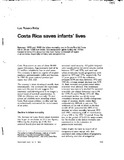Mostrar el registro sencillo del ítem
Costa Rica saves infants’ lives
| dc.creator | Rosero Bixby, Luis | |
| dc.date.accessioned | 2016-02-03T20:48:03Z | |
| dc.date.available | 2016-02-03T20:48:03Z | |
| dc.date.issued | 1988 | |
| dc.identifier.uri | https://hdl.handle.net/10669/15561 | |
| dc.description | Artículo científico -- Universidad de Costa Rica. Instituto de Investigaciones en Salud, 1988 | es_ES |
| dc.description.abstract | Costa Rica covers an area of about 50 000 square kilometres. Approximately half of its 2.5 million inhabitants live in rural areas. The economy is based on exports of tropical products, predominantly coffee and bananas. In 1983 the gross national product per capita was US$ 1020. The country is more developed socially than economically. The increased life expectancy seen over the past decade suggests that economic underdevelopment is no longer a determinant of survival opportunities. In 1984 the illiteracy rate was only 7% and almost all children were attending school. Costa Rica enjoys political stability and has constitutionally renounced the maintenance of an army. | es_ES |
| dc.description.sponsorship | Universidad de Costa Rica. Instituto de Investigaciones en Salud. | es_ES |
| dc.language.iso | en_US | es_ES |
| dc.source | World Health Forum 9: 439-443 | es_ES |
| dc.subject | Costa Rica | es_ES |
| dc.subject | infant mortality | es_ES |
| dc.subject | care programmes | es_ES |
| dc.subject | health plan | es_ES |
| dc.subject | prevention | es_ES |
| dc.subject | control of infection | es_ES |
| dc.subject | Public health | es_ES |
| dc.title | Costa Rica saves infants’ lives | es_ES |
| dc.type | artículo original | |
| dc.description.procedence | UCR::Vicerrectoría de Investigación::Unidades de Investigación::Ciencias de la Salud::Instituto de Investigaciones en Salud (INISA) | es_ES |


